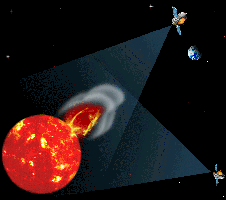
Technology Requirements (mission enhancing)
- Optimized data compression and tomographic analysis techniques
- Lightweight, ultra-low-scatter optics
- Compact, stable, interferometric filters
- Low-cost alert mode and autonomous operations
Measurement Strategy
- Image the chromosphere, corona, and interplanetary plasmas and photospheric magnetic fields from several perspectives simultaneously
- Measure plasmas, magnetic fields, and energetic particles in situ
Status
- Science Definition Team and GSFC study mission options that will lead to a Solar Terrestrial Probe launch in ~2003
- Preliminary SDT report available in 1997 May
- Final SDT report in late summer 1997
Science Objectives
- Understand the origin and consequences of coronal mass ejections (CMEs)
- Establish the magnetic field evolution that results in solar eruptions
- Improve space weather forecast capability
- Determine the 3D structure of disturbed interplanetary magnetic fields
- Discover the mechanisms and sites of energetic particle acceleration
- Determine whether CMEs control the evolution of the corona
- Probe the solar dynamo through study of cyclic phenomena in the corona and interplanetary space
Mission Description
- Solar activity imaging by two or more s/c at large angular separations from Earth
- One spacecraft orbit is 20° - 30° out of the ecliptic plane
- STEREO requires supporting observations from (near) Earth
- STEREO provides real-time event alerts for forecasters
Science Definition Team
David Rust (Chair), JHU Applied Physics LabVolker Bothmer, University Kiel
Len Culhane, University College, London
Joseph Davila, NASA Goddard Space Flight Ctr.
Richard Fisher, NASA Goddard Space Flight Ctr.
Jack Gosling, Los Alamos National Laboratory
Lika Guhathakurta, Goddard Space Flight Ctr.
Hugh Hudson, University of California - San Diego
Mike Kaiser, NASA Goddard Space Flight Ctr.
Paulett Liewer, Jet Propulsion Laboratory
Richard Mewaldt, California Institute of Technology
Marcia Neugebauer, Jet Propulsion Laboratory
Vic Pizzo, NOAA Space Environment Center
Dennis Socker, Naval Research Laboratory
Alan Title, Lockheed Martin Research Lab
February 1997